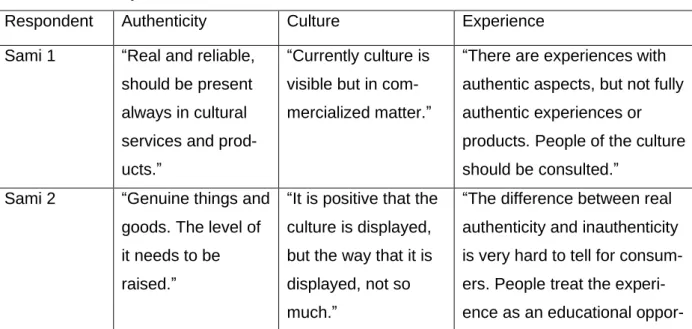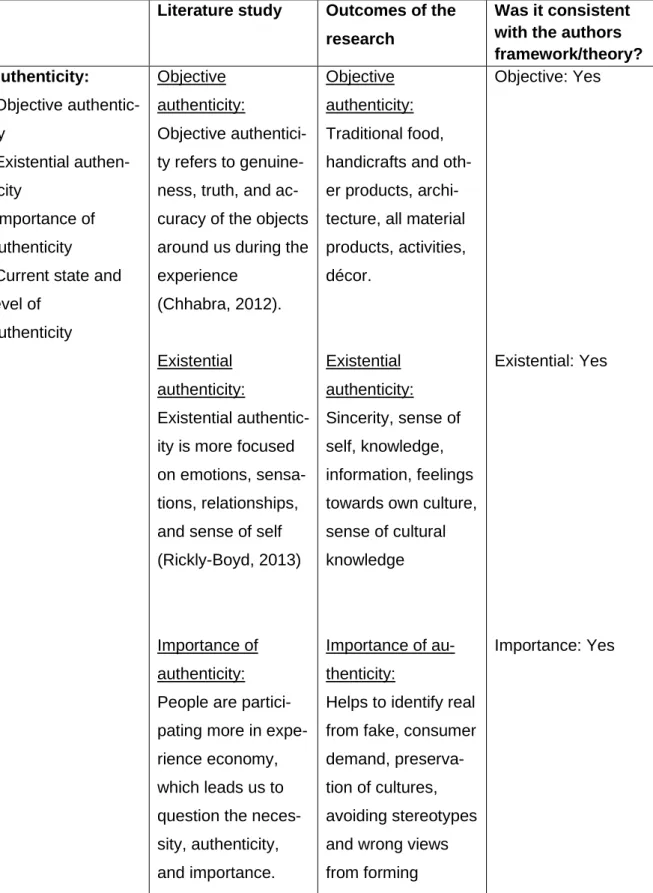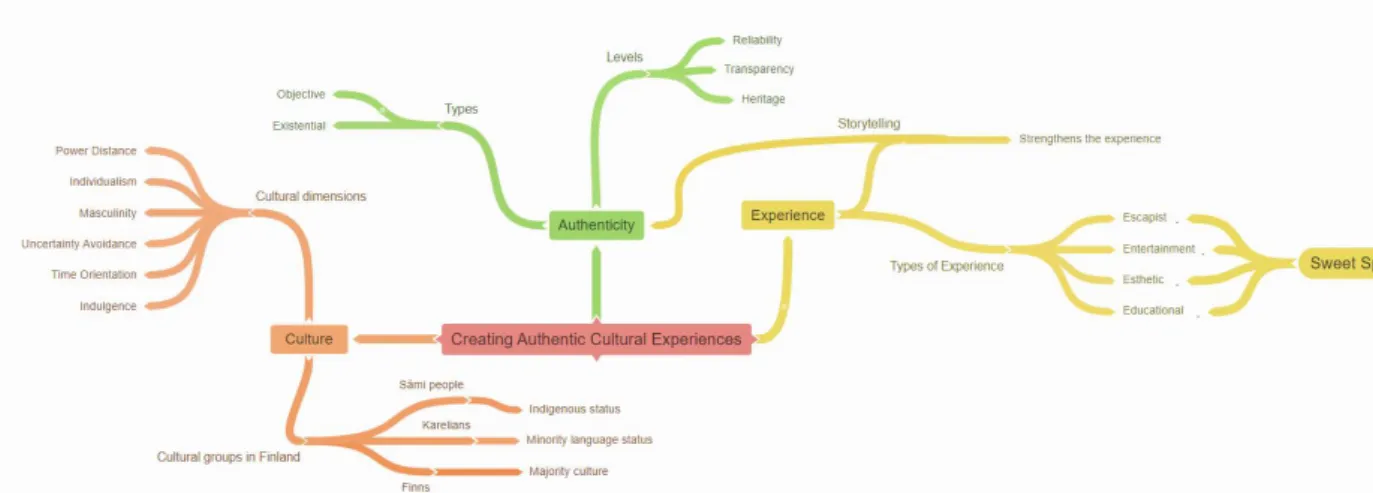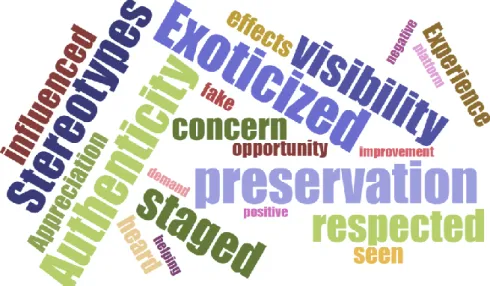In a YLE article, "Grandfather's story made Tuomo Kondie an activist who gave up his Finnish surname: "The Kalevala was stolen from the Karelians". That is why we in the industry are also responsible for preserving the cultures that are part of the delivered experiences.
Overview of the structure
Finally, the thesis will offer recommendations and advice to the industry on how to create real and authentic experiences for customers, while also taking into account the cultures they use in the experiences. Ultimately, this thesis will provide useful advice for the industry and its operations in the future.
Aims of the study
That way we can have knowledge of how the industry should work and what they should be thinking about so they don't make mistakes that could be detrimental to the culture and heritage. She wanted to use literature that is reliable and genuine according to the people belonging to those cultures, so before doing a literature search, she asked few opinions about what literature would be used for the most accurate results.
Justifications
Considering this information, we know how important it is to provide the customer with the authentic information. It is important to the author that the hospitality and experience industry operates ethically in collaboration with cultures so that harmful or unpleasant outcomes are avoided.
Definitions
- Authenticity
- Culture
- Finland as a cultural area
- Sámi
- Karelia
- Creating Experiences
Hofstede defined culture as “the collective programming of the mind that distinguishes the members of a group or category of people from others” (Rheenen, 2020). Both Finns and Sámi were listed as "Lapps" because of the livelihood they practiced in the north.
Authenticity
The demand for authenticity has meant that businesses need to listen to consumers and meet their expectations to meet current demand. Individuals' experience and sense of authenticity has been shown to be related to their satisfaction (Rathi & Lee, 2020).
Cultures in Finland
It is very interesting, how Karelian culture is researched as their own group, but also as part of the development of the Finnish national report. How an orthodox Christian group, usually associated with Russia, ends up as part of an image of Finland. Many people also support the idea that Karelia is part of Finnish culture and not an indigenous group.
As experience providers, we need to understand the culture that is part of what we provide.
Experience
Experience realms
The sweet spot is the experience that touches all of these areas, making it very enjoyable and ideal as an experience. For example, Pine and Gilmore's (2011) domain of entertainment would best align with Schmitt's (1999) 'feeling' and 'sensation' domains. Learning about these areas is important as the author wants to focus on improving and improving the experience industry in cultural experiences in Finland.
Authenticity is related to experiences, so in the thesis we will discuss the creation of experiences, authenticity and how to maintain it, how to make a commercial product while maintaining the value of the experience and ethical operation.
Storytelling
When all of these are involved in an experience, according to Gilmore and Pine (2011), it results in a sweet spot. These realms can be used to create new experiences or to improve existing ones by making them better. To understand the importance of experiences and how they are formed, it is crucial to know what goes into creating one.
Staging authenticity for experience
Historically, the performances were associated with the Gypsy population and performed in the urban areas. Flamenco has become extremely commercialized and is now commonly associated with Spanish culture (Holguín, 2019). Many people do not know the origin of this art form, which is very often offered as an experience.
We have the responsibility to learn and educate ourselves as much as we can so that we do not create any harmful stereotypes or misunderstandings.
Framework of authentic cultural experiences
The author decided to focus on different types and levels of authenticity, as this is relevant to the topic of the thesis. The things we see, feel and experience affect our view of the authenticity of the experience. We will review the target group of the research and the rationale for how participants were selected.
This chapter takes a closer look at the basics of the tool being used and data collection.
Research method
In this chapter, the author will explain and justify why she decided on this research method. One of the goals of this research is to deepen the understanding of this culture and their views, so the author wanted the interviews to be as accurate as possible. Data from the interviews were used to test whether the author's framework was valid.
After this, the author used a few days to analyze the results of the research.
Qualitative research
The author wanted to ensure that she avoided undue bias towards certain topics. The author wanted to have an equal number of representatives of both cultural groups as interviewees in the research, as it provided validity and equality to the research. This will ensure that we hear what the participants have to say, and the author can gain a deeper understanding of the topic.
The author has chosen one-on-one interviews because in this format it is easier to ask additional questions and gain a better understanding of the correctness and answers of the individual (interviewee).
Analysis and data collection process
Data collection
Most of the interviews were conducted via Zoom or regular phone calls, but 2 respondents were interviewed face-to-face. Some of the respondents lived 400-700 kilometers away, so face-to-face interviews were not possible due to the distance. She informed them about the topic of the research, the reason for doing it and the conditions of the interview.
Three of the interviews were conducted in Zoom, three interviews as a regular phone call and two as face-to-face interviews.
Data analysis
After the author gathered enough volunteers, she sent an email or message to the potential participants and asked them if they were willing to participate in the interviews. Each interviewee gave the author permission to record and use the data collected if it was used for research purposes only. The focus was authenticity, so the author explored the connection and effects of that to experiences and culture.
If the stated level of authenticity is correct, the authenticity of the service or product will benefit all aspects of an experience.
Reliability of the research
The author tried to avoid bias by using multiple literature sources and educating herself further on the topics before proceeding with the research. However, the author felt that it was important to discuss it in this chapter as personal bias may possibly affect the respondents and the researcher. The author acknowledged her personal and professional biases and took care to maintain a fresh perspective in this research.
This contributed to validity, as the author was aware of and was able to avoid showing her biases.
Ethical consideration
In this chapter, the author will discuss and present the results of the study. We will also review useful advice and results for the industry. When the collected data was arranged and converted into written form, the author noted that the ideas, opinions and feelings about the topics were very similar.
This allowed the author to collect the most frequently mentioned highlights from the interviews and organize them into a list of things to consider in the future.
Importance of authenticity
According to the collected data, there are some things that should not be used as part of objective "authenticity" in experience, unless the person displaying it is themselves part of the culture. All the participants found it important that the objective authenticity meets the genuine cultural aspects. In addition, it will help customers to get a touch of the language and will make the native people feel more included and welcome.
To avoid their disappearance, people should pay more attention to the visibility of the minority languages” – Karelian respondent 3.

Effects of the industry on the cultures
Visibility, including the language, to educate people about the culture and give something back to the culture will directly help improve the experiences.” Often the income and benefits go directly to larger companies or other people who are not within the culture. According to the seven participants, the culture is exploited and used only for commercial value.
This can cause the experience to be designed to fit the narrative of the majority culture.
Recommendations for the industry
People in the experience and hospitality field need to know the true origins and history of the cultures that are part of their product. Give something back to the indigenous people and contribute to the preservation of the cultures. If we want to give something concrete back, we need to start hearing their voices, opinions, feelings and educate ourselves about the real aspects of the culture.
The discussion of the entire topic and its relevance to the industry will be discussed in the next chapter.
Discussion of the topic
In general, the framework and theory behind the research can be proven, and the results (Chapter 4.3) are consistent with the literature review. Objective authenticity refers to genuineness, truth and accuracy of the objects around us during the experience. Many experiences are staged, and the culture seen as part of that is the commercialized and misrepresented version.
It's okay to practice it if we make sure we're depicting the culture correctly and authentically.

Conclusion of the study
If the basic knowledge is not the basis, we should not talk about that culture or represent them. We must avoid exoticizing and over-commercializing these cultures because this will lead to stereotypes and distorted image of these cultures. Instead of creating the experience for the sole purpose of sales, we should focus more on giving something back.
This means we should give something back to local communities and meet customers' demands for true authenticity.
Limitations of the research
To enhance experiences related to authenticity, people working in this field need to be more educated about culture, heritage, history and practices. Respondents seemed to think that the common problem in the industry is branding with these cultures, Sami and Karelia, but not including any cultural representatives or their languages. Especially if they are mass produced and none of the profits go to the people who are part of these cultures.
It guides and helps in identifying the scope of previous works done in the research area.
Suggestions for future research
The literature search required the author to review books outside of the immediate topic in order to understand certain points and issues. So in this case it could technically be interpreted as a restriction, but in practice it was an extension of the answers. The history of cultures and heritage can be examined from the perspective of indigenous and dominant cultures and then compared.
The question of experience can be examined through the pyramid of experience rather than spheres of experience.
Evaluation of learning through the thesis process
Available at: https://www.socialmediatoday.com/news/survey-finds-consumers-crave-authenticity-and-user-generated-content-deli/511360/. Available at: https://www.oph.fi/fi/koulutus-ja-kirjaliust/suomen-kieli-ja-kirjalisuus [Accessed 5 October 2021]. Available at: https://www.communicaid.com/cross-cultural-training/blog/indulgence-vs-restraint-6th-dimension/.
Available at: https://www.livescience.com/21478-what-is-culture-definition-of-culture.html [Accessed 22 September 2021].
Interview plan

